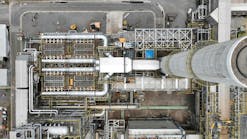Russia's NefteGazIndustriya advances refinery modernization
Robert Brelsford
Downstream Technology Editor
NefteGazIndustriya LLC, through a project developer, has let a contract to CB&I, Houston, to provide equipment for work related to the modernization of its 5.25 million-tonne/year Afipsky refinery at Krasnodar, Russia.
CB&I will provide detailed engineering, procurement, fabrication, and supply of a steam methane reformer for a large-scale hydrogen plant and hydrocracking heaters, as well as Lummus Advanced Breech-Lock heat exchangers, CB&I said.
Licensed by CB&I subsidiary Lummus Technology Inc., Breech-Lock exchangers feature a closure-system design that enables reliable sealing of high-pressure, high-temperature fluid flows, easy dismantling for inspection and reassembly, avoidance of high-stressed zones in pressure parts, and flexibility for retightening inner seals during unit operation, according to the service provider's web site.
The value of the contract exceeds $90 million, CB&I said.
This latest contract follows a series of previous contract awards to CB&I for work related to Afipsky's revamp.
Last year, NefteGazIndustriya let a contract to CB&I to provide technology and front-end engineering and design (FEED) services for multiple process units involved in the modernization, including a 2.5 million-tpy hydrocracker unit licensed by Chevron Lummus Global, as well as CB&I-licensed hydrogen and sulfur units (OGJ Online, July 1, 2014).
CB&I also will provide technology and FEED services for a crude distillation unit, vacuum distillation unit, and visbreaker that will utilize the Shell Soaker Visbreaking technology jointly licensed by CB&I and Shell.
Earlier this year, the Russian refiner contracted CB&I to also deliver detail engineering and procurement services for the hydrocracker, hydrogen and sulfur units, and other associated units included in the revamp (OGJ Online, Apr. 20, 2015).
The revamp project
Designed to increase the refinery's processing capacity and oil conversion ratio in order to improve product quality, the three-phased Afipsky modernization project will include the expansion and renovation of the existing refinery as well as the construction of a high-conversion refinery at the site.
Stage 1 will involve the expansion of current production installations to increase the refinery's crude oil processing capacity to 6 million tpy and to optimize feedstock supply logistics.
Stage 2 of the project will include building a high-conversion refinery in order to lift the site's oil conversion ratio to 82% and boost production of products with specifications that meet requirements of the Technical Regulations of the Customs Union of Russia.
A third and final stage of the modernization will involve construction of a delayed coking unit designed to increase the complex's oil conversion ratio to 93% and maximize production of both Euro 5 diesel fuel and light oil, NefteGazIndustriya said.
Alongside the hydrocracking, distillation, and visbreaking units, the high-conversion refining complex also will include a diesel fuel hydrotreater, according to the Russian refiner.
While NefteGazIndustriya has yet to reveal a detailed timetable for the project's completion, the company has said it plans to begin production of Euro 5 diesel and vacuum gas oil at Afipsky during 2015.
BHI: US rig count falls 6 units to 857
The US drilling rig count fell 6 units to reach 857 during the week ended July 17, essentially cancelling out the last 3 weeks' worth of gains, according to data from Baker Hughes Inc.
The losses came from rigs drilling on land and in inland waters. Land rigs were down 3 units to 824, while those targeting inland waters also fell 3 units to reach 2 rigs working.
During the week, rigs targeting oil fell 7 units to 638. Gas-directed rigs, meanwhile, were up 1 unit to 218. Rigs considered unclassified were unchanged at 1 rig working.
Rigs engaged in horizontal drilling fell 4 units to 650. Directional drilling rigs lost 4 units to 84.
Rigs drilling offshore and in the Gulf of Mexico were both unchanged, each maintaining counts of 31.
Canada's rig count continued its upward climb, jumping 23 units to 192. Its count has now risen in 8 of the last 10 weeks. The most recent gain was spurred by a rebound in gas-directed rigs, which rose 16 units to 94. Oil-directed rigs, meanwhile, increased 7 units to 98 rigs working. Canada's overall count is still down 189 year-over-year.
Among the major oil- and gas-producing states, Louisiana lost 3 units to reach 69 rigs working. Texas, North Dakota, and Pennsylvania each were down 2 rigs, reaching respective totals of 366, 68, and 43. Oklahoma, at 105, and California, at 11, were each down 1 unit. Unchanged from a week ago were Wyoming, 21; Ohio, 19; West Virginia, 18; Utah, 7; and Arkansas, 4. Four states gained a single rig this week: New Mexico, 50; Colorado, 39; Alaska, 11; and Kansas, 11.


